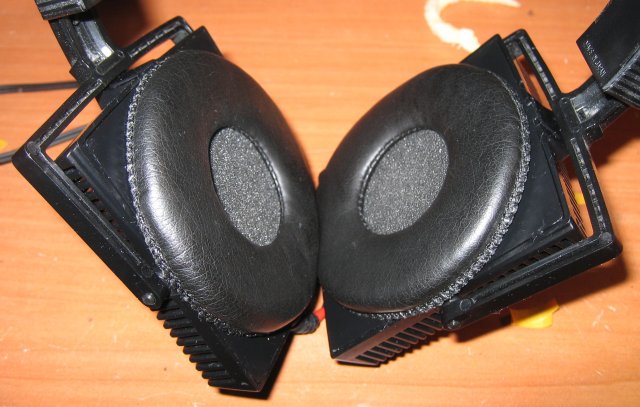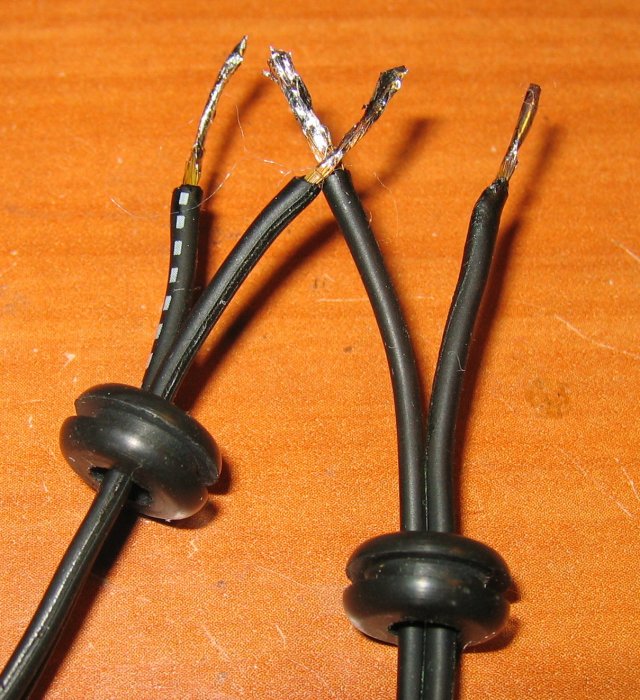ericj
Headphoneus Supremus
- Joined
- Aug 2, 2005
- Posts
- 8,270
- Likes
- 170
Many of you are aware of this phenominon - you get up one morning bright and early, stumble over to your computer, check your email, poke around ebay a bit, and before you know it you've bought something that maybe you should have left alone.
I bought a dog-eaten Stax SR84 kit. Yes, dog-eaten. At least, there sure seemed to be tooth marks on the earpads, and the earcups were pretty much shattered, if you can call them cups - the lambda-style frame is completely open-backed. And one side's cable had been shortened about 4 inches.
And a previous owner had replaced broken struts with some sort of aluminum contraption. I almost admired the tenacity, but, I still felt pretty stupid for paying as much as i did for what i got, which was basically a pair of SR-80 Pro drivers, SR-80 baffles, and an SRD-4 transformer box, along with a bunch of broken junk.
These are electret headphones. They are true electrostatics, but with no bias voltage. They are generally considered to be good, but not quite as good as full blown electrostats.
While Micro-Seiki and Toshiba both made excellent electret headphones back in the day (which were OEMed by the likes of Sony and Rotel), with few to no compromises made in the build quality, the Stax electrets are somewhat fragile.
Edit: I hate to admit it but Sony made their own electrets, and they were fairly good. Pioneer likely did as well in their SE-100 model.
Nearly everything is plastic, and the struts frequently break.
Initially i transplanted the drivers into the SR-30 that duderuud sold me. Since the SR-30 came with one dying driver, and both SR-80 drivers work fine, it made sense. It worked but really wasn't the fulfilling, so-called "lambda junior" experience I'd envisioned while making my bleary-eyed "buy it now" purchase.
Eventually i acquired a 2nd broken SR-30 from KurtW. This pair turned out to have a better headband than duderuud's pair, but with a broken strut, and missing the pins that hold the earcups together, and a bad cable, but what turned out to be two good drivers.
After some begging and pleading, wualta sent me some parts from his wrecked SR-80 Pro set, and i finally had enough pieces to build two complete sets. One SR-30, one SR-80 Pro.
Here's the basic parts of the earcup:

As you can see, the "cup" is just an open, acoustically-transparent frame, with a thin lining of an open-celled foam slightly less substantial than window screening.

The driver element is held in with double-sided tape. Under the white heatshrink is a pair of varistors that serve to protect the driver from over-voltage.
The white heatshrink is mine. Usually in an SR-80 the varistors would be open to the air, with the leads twisted around the posts in the lower left-hand corner of the baffle. What you see here is the SR-30 configuration, which works in the SR-80 frame anyway.

That pad in the middle of the back of the driver *looks like fiberglass, but it isn't. We don't know what it is. Only Stax, Fostex, and Audio-Technica seem to use the stuff.
It's more centered than it looks in the picture.

Here it is assembled, though i mistakenly used SR-30 pins on the SR-80.
These pins are all that hold the earcup assembly together, and hold the earcups in the struts. This is actually an upgrade over the earlier Stax design where the struts themselves were the only thing holding the earcup together, and a quick move could leave your earspeaker parts scattered all over the livingroom.

The other driver is missing the damping pad.
The SR-30 and SR-80 drivers are the same size, and some have speculated that they are the same driver, but the SR-30 has a bigger damping pad than the SR-80. Since i have four SR-30 drivers and only three of them work, I cut down an SR-30 damping pad to the SR-80 size.


I used double-sided sticky tape similar to the tape that holds the driver onto the baffle here. I could have used glue, but then i'd have to wait for it to set.

Like i said before, the SR-80 pads i have are dog-eaten. They're pretty flat anyway. So, here's one of the SR-30 pads i got from KurtW next to a foam lining from an HD-25, which i figure is vaguely similar to the original SR-80 foam lining - maybe a bit larger diameter.
I'm attempting to use the same doubletape to hold them onto the frames while i make new SR-80 earpads. I've picked one of the old SR-80 earpads apart to use as a pattern to cut out some of the same suede i used on my SE-700 headband. Should be more comfortable than the original earpads, when i finally get them stitched up and stuck on.

Here they are all together.
I bought a dog-eaten Stax SR84 kit. Yes, dog-eaten. At least, there sure seemed to be tooth marks on the earpads, and the earcups were pretty much shattered, if you can call them cups - the lambda-style frame is completely open-backed. And one side's cable had been shortened about 4 inches.
And a previous owner had replaced broken struts with some sort of aluminum contraption. I almost admired the tenacity, but, I still felt pretty stupid for paying as much as i did for what i got, which was basically a pair of SR-80 Pro drivers, SR-80 baffles, and an SRD-4 transformer box, along with a bunch of broken junk.
These are electret headphones. They are true electrostatics, but with no bias voltage. They are generally considered to be good, but not quite as good as full blown electrostats.
While Micro-Seiki and Toshiba both made excellent electret headphones back in the day (which were OEMed by the likes of Sony and Rotel), with few to no compromises made in the build quality, the Stax electrets are somewhat fragile.
Edit: I hate to admit it but Sony made their own electrets, and they were fairly good. Pioneer likely did as well in their SE-100 model.
Nearly everything is plastic, and the struts frequently break.
Initially i transplanted the drivers into the SR-30 that duderuud sold me. Since the SR-30 came with one dying driver, and both SR-80 drivers work fine, it made sense. It worked but really wasn't the fulfilling, so-called "lambda junior" experience I'd envisioned while making my bleary-eyed "buy it now" purchase.
Eventually i acquired a 2nd broken SR-30 from KurtW. This pair turned out to have a better headband than duderuud's pair, but with a broken strut, and missing the pins that hold the earcups together, and a bad cable, but what turned out to be two good drivers.
After some begging and pleading, wualta sent me some parts from his wrecked SR-80 Pro set, and i finally had enough pieces to build two complete sets. One SR-30, one SR-80 Pro.
Here's the basic parts of the earcup:

As you can see, the "cup" is just an open, acoustically-transparent frame, with a thin lining of an open-celled foam slightly less substantial than window screening.

The driver element is held in with double-sided tape. Under the white heatshrink is a pair of varistors that serve to protect the driver from over-voltage.
The white heatshrink is mine. Usually in an SR-80 the varistors would be open to the air, with the leads twisted around the posts in the lower left-hand corner of the baffle. What you see here is the SR-30 configuration, which works in the SR-80 frame anyway.

That pad in the middle of the back of the driver *looks like fiberglass, but it isn't. We don't know what it is. Only Stax, Fostex, and Audio-Technica seem to use the stuff.
It's more centered than it looks in the picture.

Here it is assembled, though i mistakenly used SR-30 pins on the SR-80.
These pins are all that hold the earcup assembly together, and hold the earcups in the struts. This is actually an upgrade over the earlier Stax design where the struts themselves were the only thing holding the earcup together, and a quick move could leave your earspeaker parts scattered all over the livingroom.

The other driver is missing the damping pad.
The SR-30 and SR-80 drivers are the same size, and some have speculated that they are the same driver, but the SR-30 has a bigger damping pad than the SR-80. Since i have four SR-30 drivers and only three of them work, I cut down an SR-30 damping pad to the SR-80 size.


I used double-sided sticky tape similar to the tape that holds the driver onto the baffle here. I could have used glue, but then i'd have to wait for it to set.

Like i said before, the SR-80 pads i have are dog-eaten. They're pretty flat anyway. So, here's one of the SR-30 pads i got from KurtW next to a foam lining from an HD-25, which i figure is vaguely similar to the original SR-80 foam lining - maybe a bit larger diameter.
I'm attempting to use the same doubletape to hold them onto the frames while i make new SR-80 earpads. I've picked one of the old SR-80 earpads apart to use as a pattern to cut out some of the same suede i used on my SE-700 headband. Should be more comfortable than the original earpads, when i finally get them stitched up and stuck on.

Here they are all together.









